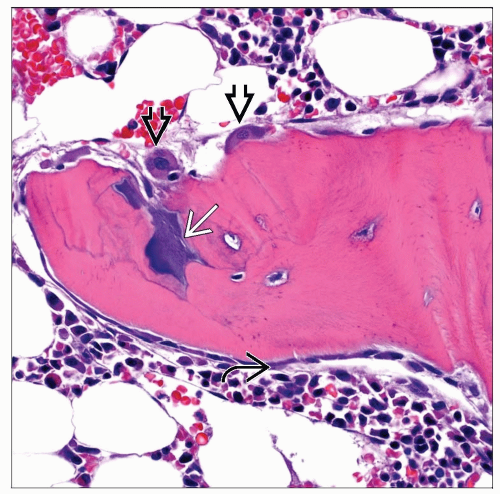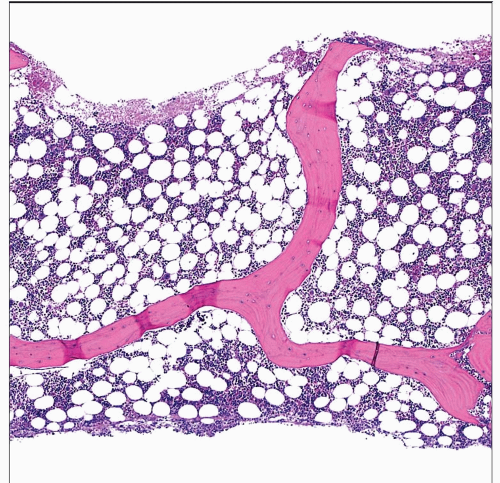Bone Abnormalities in Bone Marrow Specimens
Kathryn Foucar, MD
Key Facts
Terminology
Bony trabeculae composed of central, mineralized, mature bone and peripheral, newly formed unmineralized bone matrix termed osteoid
Provide support for bone marrow microenvironment and HP meshwork
Marked variations in bony trabeculae and osteoblastic and osteoclastic activity based on age and gender
Osteoblasts, mesenchymal stem cell-derived cells
Produce osteoid
Play key role in regulation of HP
Osteocytes are osteoblasts that have been internalized within lacunar spaces of mineralized bone
Play key role in bone homeostasis
Undergo apoptosis with aging
Osteoclast, HP stem cell-derived
Multinucleated bone resorbing-cell of monocyte/macrophage lineage
Prominent bone remodeling normal in children
Substantial amounts of unmineralized osteoid in specimens from infants and very young children
Thicker bony trabeculae and greater bone remodeling in adolescent/young adult males compared with females and older adults
Types of bone disorders
Osteopenia, osteoporosis
Osteolysis, osteonecrosis
Osteosclerosis
Renal osteodystrophy
Paget disease
Osteomalacia
Osteopetrosis
TERMINOLOGY
Definitions
Bony trabeculae and associated cellular constituents are evident on all core biopsy sections
Bony trabeculae composed of central, mineralized, mature bone and peripheral, newly formed unmineralized bone matrix termed osteoid
Provide support for bone marrow microenvironment and hematopoietic (HP) meshwork
Marked variations in bony trabeculae and osteoblastic and osteoclastic activity based on age and gender
Osteoblasts, mesenchymal stem cell-derived
Produce osteoid
Play key role in regulation of HP
Osteocytes are osteoblasts that have been internalized within lacunar spaces of mineralized bone
Key role in bone homeostasis
Likely induce osteoclast and osteoblast activity in response to bone injury
Undergo apoptosis with aging
Osteoclasts, hematopoietic stem cell-derived
Multinucleated bone-resorbing cell of monocyte/macrophage lineage
Resides with Howship lacunae along periphery of bony trabeculae
Types of bone disorders/conditions evident on iliac crest bone marrow core biopsy section
Age-/gender-related variations
Prominent bone remodeling in children
Substantial amounts of unmineralized osteoid in specimens from infants and very young children
Thicker bony trabeculae and greater bone remodeling in adolescent/young adult males compared with females and older adults
Osteopenia
Thinning of bony trabeculae
Imbalance of bone homeostasis
Reduced new bone formation
Termed osteoporosis if generalized and associated with reduced bone density testing
Osteolysis
Discrete area of excessive osteoclast-induced bone resorption
Osteonecrosis
Nonviable bony trabeculae with loss of osteocytes within lacunar spaces
May be associated with necrosis of medullary (HP) cavity
Osteosclerosis
Thickened bony trabeculae that may be anastomosing
Radiographically apparent when generalized and prominent
Often associated with fibrosis
Linked to neoplastic and nonneoplastic disorders of bone and bone marrow
Renal osteodystrophy
Variable features of bony trabeculae and bone marrow stroma over time
Spectrum of sequelae from low and high bone turnover
Bone erosion, bone formation, and quiescent phases
May see bony trabecular changes linked to secondary hyperparathyroidism
May see changes linked to osteomalacia with defective mineralization
May see bone islands within medullary space
Osteomalacia
Excessive osteoid formation with defective mineralization
Linked to selected renal disorders
Constitutional and acquired types
Paget disease
Osteopetrosis
Constitutional disorder caused by mutations in genes expressing proteins linked to osteoclastic bone resorption
Markedly expanded and confluent bony trabeculae with increased bone density and dramatically reduced HP space
ETIOLOGY/PATHOGENESIS
Complex mechanisms necessary for bone homeostasis
Adequate calcium phosphorus, vitamin D, and other factors necessary
Normal numbers and function of osteoblasts, osteoclasts, osteocytes, vasculature, stem cells, and regulatory factors required
Factors that elicit bone marrow fibrosis may affect bony trabeculae
Age-related factors including estrogen deficiency linked to osteocyte apoptosis and loss of regulation of bone remodeling by osteocytes
Constitutional disorders linked to defective function of osteoclasts and other key constituents of bone homeostasis
CLINICAL ISSUES
Epidemiology
Incidence
Osteopenia/osteoporosis very common in elderly, especially postmenopausal women
Osteosclerosis elicited by many neoplastic and nonneoplastic disorders
Generally occurs in adults
No gender predilection
Rare constitutional disorders such as osteopetrosis and some types of osteomalacia manifest in infancy, early childhood
Severe hematopoietic compromise is characteristic
Laboratory Tests
Comprehensive biochemical assessment of bone constituents and factors linked to bone formation, resorption, and remodeling
Tests for renal and parathyroid function
Various methodologies to assess bone
Treatment
Highly variable, dependent on type of bone abnormality and underlying disorders
Bone marrow transplant in infancy necessary in constitutional disorders such as osteopetrosis
Disease Course
Highly variable and dependent on type of bone abnormality and potential underlying neoplastic and nonneoplastic disorders
MICROSCOPIC PATHOLOGY
Blood
Highly variable blood picture depending on underlying cause of bony trabeculae abnormalities
Bone Marrow Aspirate
Highly variable aspirate smears depending on underlying cause of bony trabeculae abnormalities
Bone marrow frequently inaspirable in cases with associated bone marrow fibrosis
Bone Marrow Core Biopsy
Must be at least 1 cm in length
Must show intact, not crushed, bony trabeculae and medullary cavity
Assess thickness, uniformity, and contours of bony trabeculae
Assess for relative proportions of osteoid and mineralized bone including osteoid seams and cement lines
Assess for thickening and anastomoses of bony trabeculae
Assess lacunar spaces for intact, viable osteocytes or empty lacunar spaces in nonviable bony trabeculae
Assess for tiny disconnected strands of bony trabeculae (bone islands)
Assess for composite/mixed features of thickened and thinned bony trabeculae with bone islands
Typical feature of chronic renal disease
Bone islands are disconnected thin segments of bony trabeculae within medullary space
Assess for evidence of osteosis fibrosa cystica
Islands of osteoblasts and stroma within bony trabeculae
Assess for osteoblast rimming
Number and extent
Assess for osteoclasts
Number
Howship lacunae localization
Access for associated fibrosis &/or necrosis of medullary cavity
Assess for other bone marrow stromal abnormalities
Stay updated, free articles. Join our Telegram channel

Full access? Get Clinical Tree







